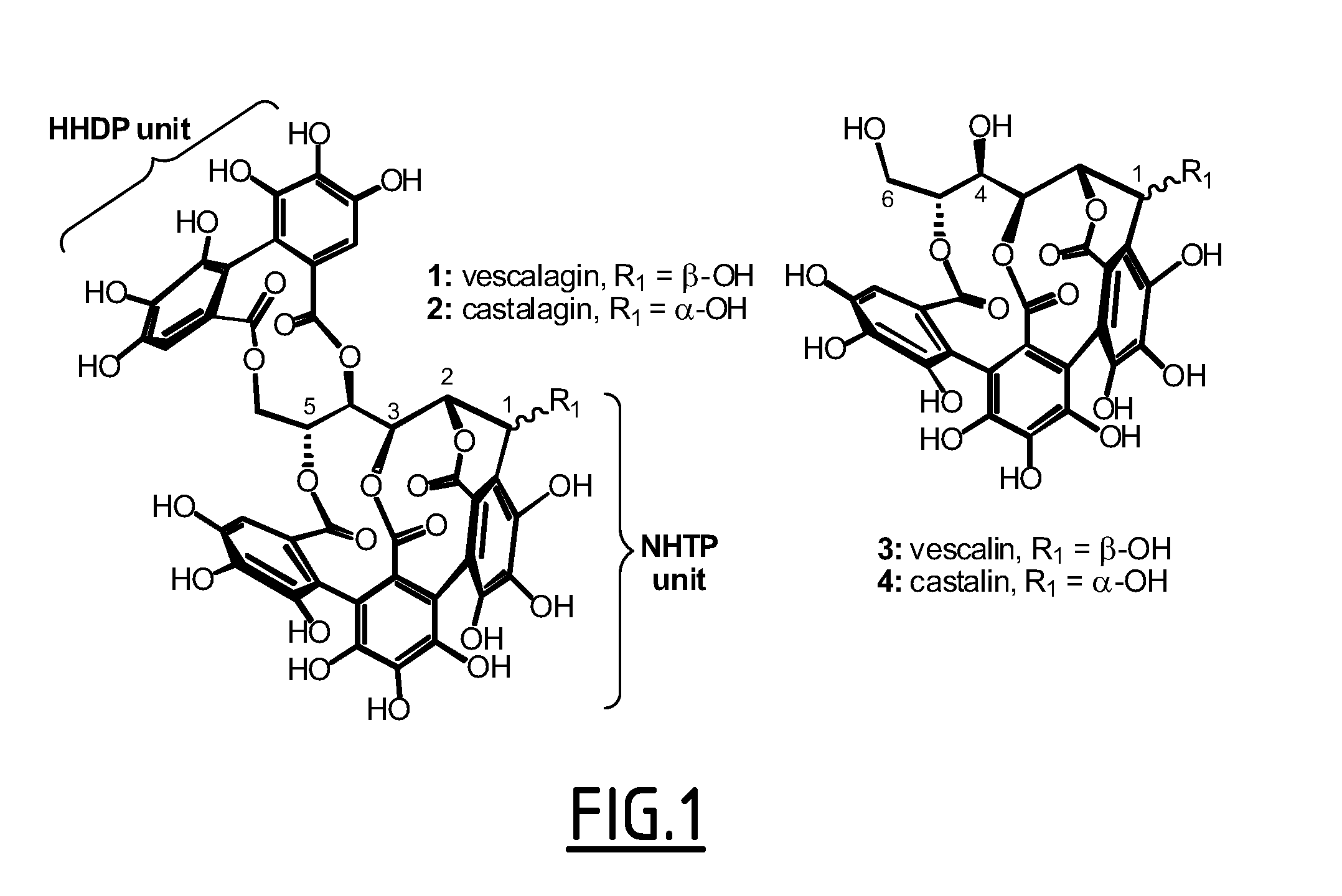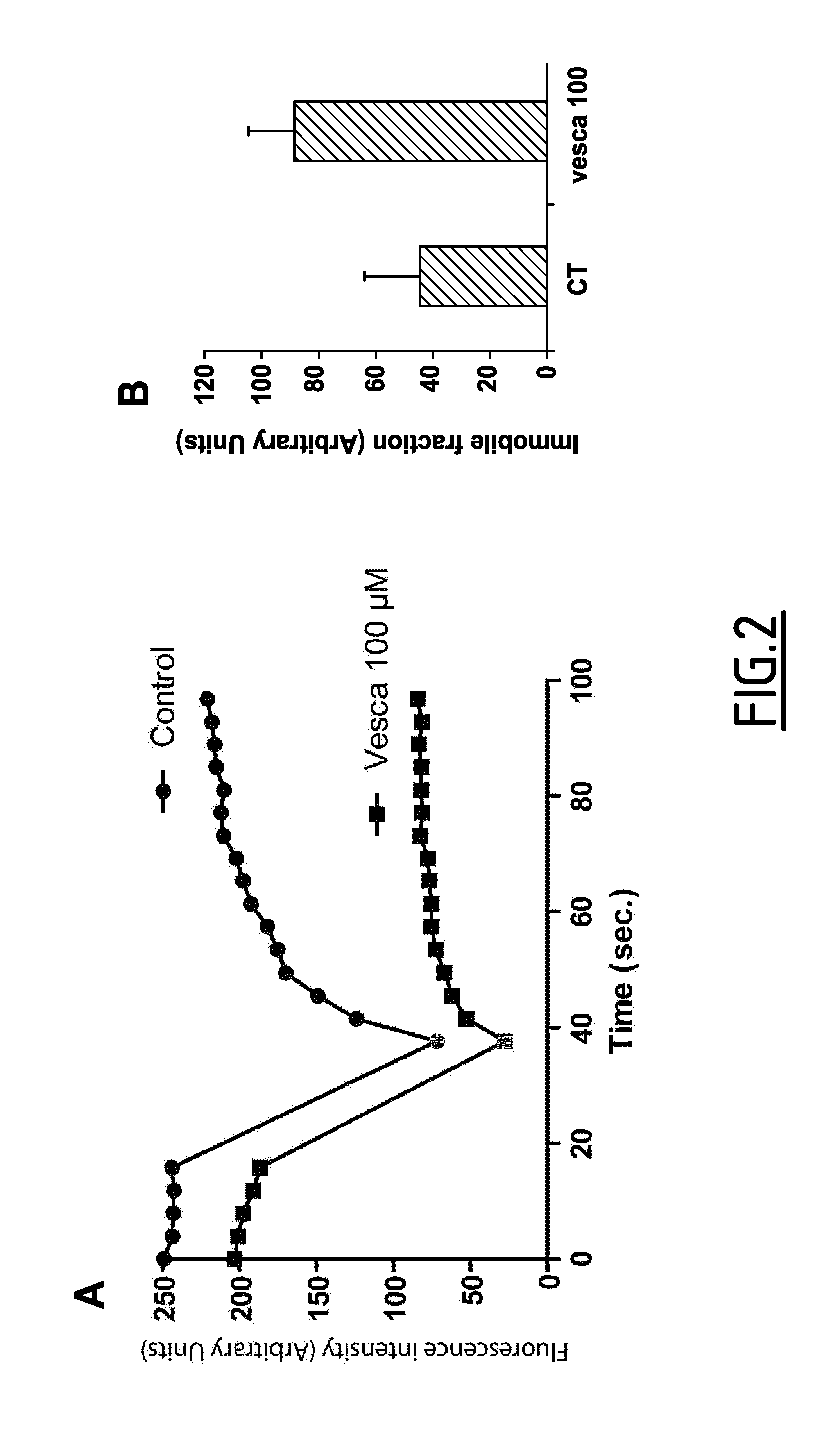C-glucosidic ellagitannin compounds for use for altering the supramolecular arrangement of actin and for the treatment of osteoporosis, cancer, bacterial infection and viral infection
a technology of ellagitannin and cglucosidic ellagitannin, which is applied in the field of cglucosidic ellagitannin compounds, can solve the problems of inability to cure, lack of differentiation, and inability to regulate growth, and achieve the effects of reducing the risk of metastasis, reducing the number of patients, and increasing the risk of infection
- Summary
- Abstract
- Description
- Claims
- Application Information
AI Technical Summary
Benefits of technology
Problems solved by technology
Method used
Image
Examples
example 1
C-Glucosidic Ellagitannins Induce Changes in Actin Configuration
[0077]Vescalagin belongs to a particular group of ellagitannins, essentially occurring in plant species of only three subclasses of the Cronquist angiosperm classification (i.e., Hamamelidae, Rosidae and Dilleniidae), and which comprises a very unique series of highly hydrosoluble C-glucosidic variants in that the usual glucopyranose core is replaced by a rarely encountered-in-nature open-chain glucose resulting from the establishment of their C-aryl glucosidic bond. Another structural feature of several of these C-glucosidic ellagitannins, including vescalagin, is the presence of a nonahydroxyterphenoyl (NHTP) unit triply connected at positions 2, 3 and 5 of their glucose core (FIG. 1).
[0078]The inventors' initial interest in studying these C-glucosidic ellagitannins stems from the premise that the highly pre-organized medium-sized ring-containing multiple-phenol array featured by such natural products should be struct...
example 2
Vescalagin Induces Rapid and Sustained Effects on Cellular Morphology
[0080]The vescalagin-induced F-actin disrupting effect seen in BAEc was also observed in fibroblast cells (baby hamster kidney cells, BHK), which also express β-actin as the main actin isoform, as well as in smooth muscle cells (A7r5), which in contrast predominantly express α-actin. Vescalagin induced similar collapse of F-actin bundles and cell contraction, but with varying potencies. Although subtle differences were noted among the three cell types tested, the impact of vescalagin on the actin cytoskeleton appeared neither cell- nor actin isoform-specific, suggesting that vescalagin can affect all types of mammalian cells. Furthermore, like in the case of cytochalasin D, no alteration of the microtubule network could be detected upon treating cells with vescalagin, indicating a specificity of this ellagitannin for actin. Remarkably, all cytoskeletal alterations could be completely reversed by washing out vescala...
example 3
Vescalagin Affects Both Thin and Thick Actin Fibers
[0082]Live imaging carried out on BAEc expressing an actin-GFP construct and treated with vescalagin at 100 μM demonstrated immediate alteration of actin-GFP distribution at cell margin. Destabilization of the stress fibers was visualised by the progressive loss of filamentous staining, concomitantly with cell retraction as observed in phase contrast. Noticeably, thick F-actin bundles were maintained. To detect and unveil the internal dynamics of these apparently immobile F-actin bundles, the inventors performed a fluorescence recovery after photobleaching (FRAP) assay on actin-GFP expressing BAEc in the absence or presence of vescalagin (FIG. 2). The results indicate that vescalagin increases the immobile fraction of actin trapped into F-actin bundles and, therefore, also affects actin dynamics within these thick F-actin bundles. From these experiments, the inventors conclude that vescalagin affects both thin and thick actin fibers...
PUM
| Property | Measurement | Unit |
|---|---|---|
| cell adhesion | aaaaa | aaaaa |
| solubility | aaaaa | aaaaa |
| volume | aaaaa | aaaaa |
Abstract
Description
Claims
Application Information
 Login to View More
Login to View More - R&D
- Intellectual Property
- Life Sciences
- Materials
- Tech Scout
- Unparalleled Data Quality
- Higher Quality Content
- 60% Fewer Hallucinations
Browse by: Latest US Patents, China's latest patents, Technical Efficacy Thesaurus, Application Domain, Technology Topic, Popular Technical Reports.
© 2025 PatSnap. All rights reserved.Legal|Privacy policy|Modern Slavery Act Transparency Statement|Sitemap|About US| Contact US: help@patsnap.com



